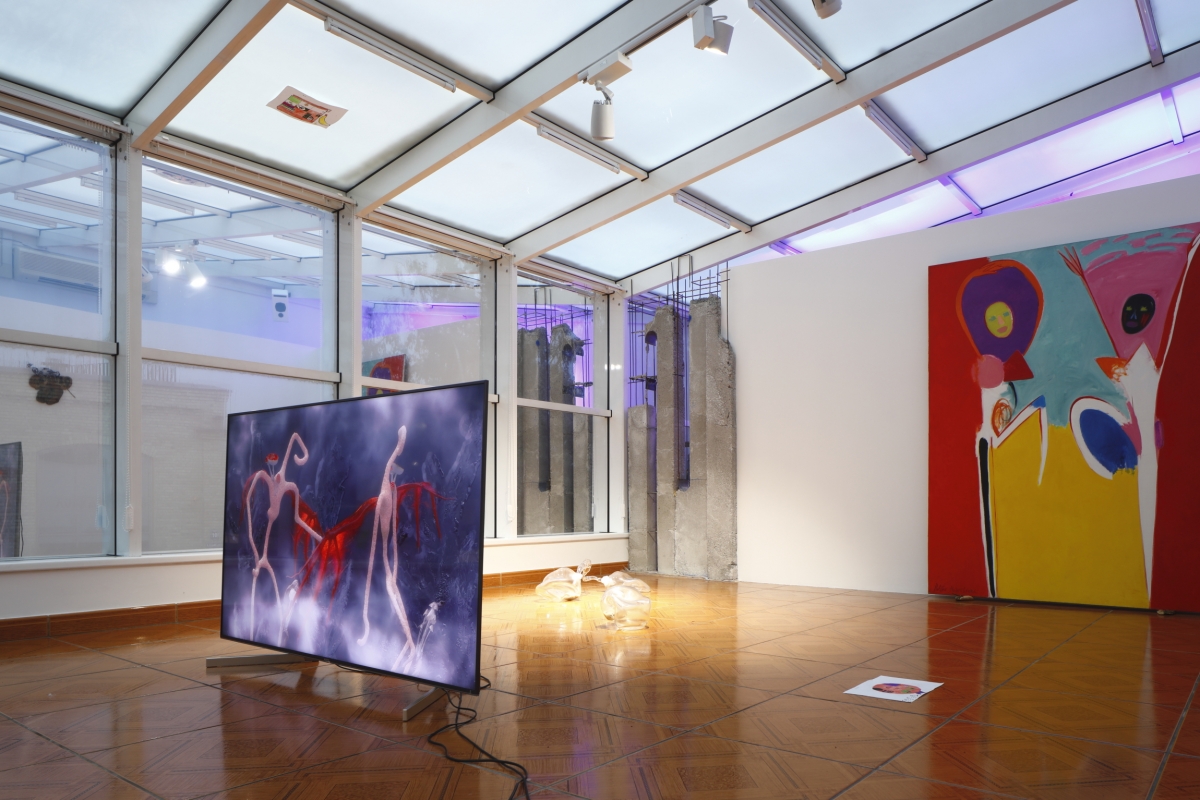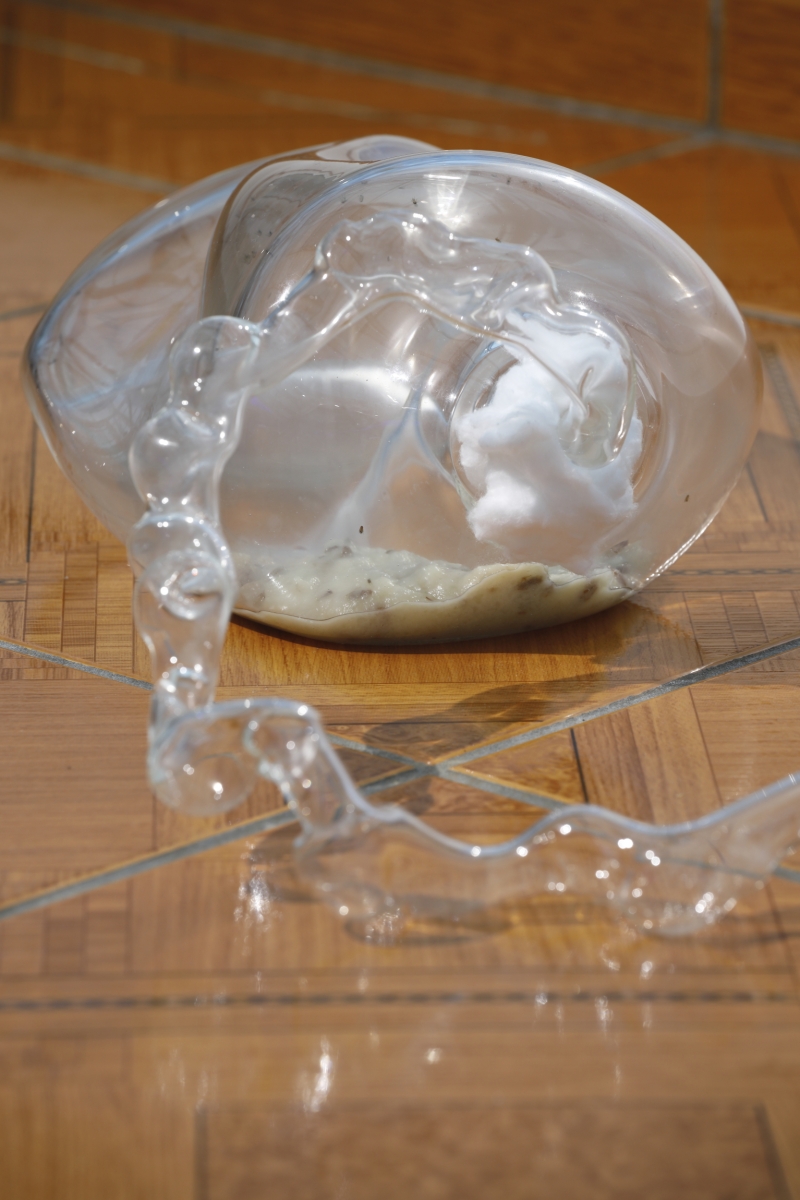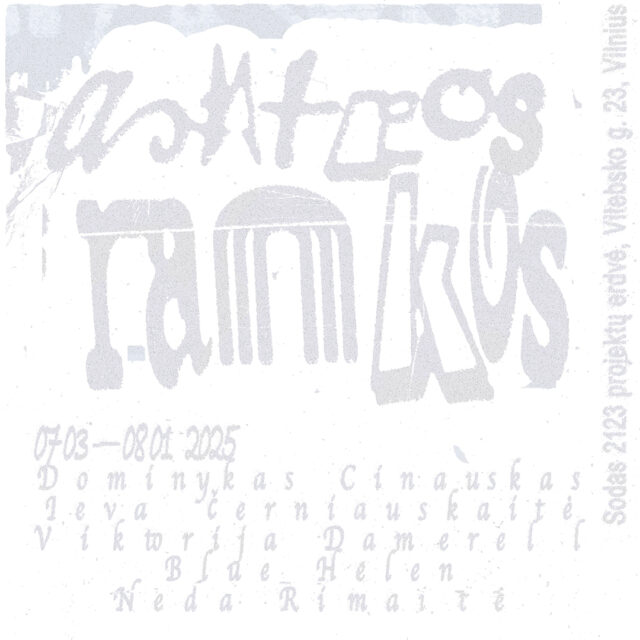The sex lives of fruit flies
Low gallery, Riga
August 25 – September 30, 2021
Participants: children, fruit flies, Mark Eckstrand, Adrian Ganea & Chlorys, Mindaugas Gapševičius, Helena Heinrihsone, Kamilė Krasauskaitė, and other significant and nonhuman others
Designer: Nerijus Rimkus
Curated by Valentinas Klimašauskas
A new wave of pandemics brings us another opportunity to reconcile with the agency and representation of nonhuman others. Something very common for this time of the year — a fruit fly — could be used as the metonymy for the non-human. Living nearby, together, and being visible, it could reveal how non-humans may be imagined, understood and treated artistically, practically, or scientifically.
The exhibition title, which refers to the overwhelming intimate lives of fruit flies, is a found clickbait. This situation refers to the phenomenon that the fruit fly, “Drosophila melanogaster”, is commonly used as a human substitute in scientific experiments to understand human behaviour and its genome. The fruit fly is used as a model organism to study disciplines ranging from fundamental genetics to the development of tissues and organs. The Drosophila genome is 60% homologous to that of humans, less redundant, and about 75% of the genes responsible for human diseases have homologs in flies. Fruit flies are instrumental in the production of scientific imagination where they also serve as human projections or representations. Fruit flies are popular among the scientific community because they are expendable, easy to control, count, monitor, and have clearly expressed genders.
However, you might want to hear more about the clickbait title experiment. Scientists used a technique called optogenetics, which involves the use of light to control neurons. In this case, scientists knew which neuron controlled the release of sperm. By exposing the fruit fly to a red light, they were able to activate that neuron, causing them to ejaculate. The work implies that sexual pleasure — and in this case — an overwhelming one, is not limited to mammals. One more indicator that fruit flies enjoy sex is their reaction to alcohol — sexually deprived male flies prefer an alcohol drink over a non-alcoholic one, seemingly as an alternative reward.
According to various articles that popularise science, scientists already know a fair amount about fruit fly intimacies. According to one such article, the male fruit fly’s penis has sharp hooks and spines that serve as Velcro, letting it keep hold of the female. The same article states that fruit-fly
semen is a strange brew, containing chemicals that can stimulate the female to lay more eggs (thereby increasing the male’s reproductive success), store more of his sperm, dull her interest in other males that come along, and make her more aggressive toward other females. A fruit fly could find itself trapped in worse experiments. In one, they have their genitals lasered, or vivisected, or their circadian-clock genes removed, forcing fruit flies to drift from test tube to test tube not knowing what time of day it is.
Apparently, for decades scientists have detailed the intricacies of ‘male’ fruit fly sexual behaviour and neurobiology. This isn’t the first time someone notices science’s tendency to prioritise male sexuality and males in general. There are studies demonstrating that scientists display a marked preference toward studying male genitalia, as opposed to female genitalia. This, some researchers say, has to do with how obvious the fruit fly males’ behaviours are — they’re easier to study and are more eye-catching; however, others suggest it has more to do with the lens through which scientists look at male and female behaviours.
However, from one research to another, a pattern emerges. The brain’s reward system, whether fly or human, seems to be rather rudimentary, seemingly reinforcing one behaviour when another isn’t possible. This thought also allows us to interpret this exhibition as an experiment that would include not just non-humans but also its spectators, lured by its clickbait title, familiar names or a possible glass of yeast drink at the opening, among other things. Or forget the barfly reference and think how abstract forms and shapes, the smell of bread, vivid colours, lights, or the soundtrack might activate certain brain neurons and how aesthetics also may be interpreted as a certain alternative reward.
The open question is, what kind of a reward and a reward for what exactly?
“”””””””
Artists, artworks, experiments and participants in the exhibition:
+ Proposals for fruit flies housing. Drawings on paper in various sizes by pupils of Beržai progymnasium of Panevėžys and kids from Algimantas Bandza Social Services Home. 2021
+ Adrian Ganea & Chlorys “My bacterial self helps me sleep”. Digital video, 3D animation. 2020.
Inspired by elusive (non)lifeforms and their abilities to shapeshift, the artists composed their work around texts and ideas of Reza Negarestani, Clark Ashton Smith, Paul B. Preciado, Octavia E. Butler, Ben Woodard, Thomas Ligotti. With a particular interest in the ecology of the nonhuman, a work explores and studies shapeless masses, slippery sludges, and slime structures. As these are often associated with decomposition, mere traces of residues, trails of verminous lifeforms, they provided the template for all organic beings and all eventual thoughts on Planet Earth. Also, let’s not forget that humanity’s gradual ascent begin in clustered pools of ooze — globs of swarming proto-life.
+ Mark Eckstrand and Kamilė Krasauskaitė “Our Beautiful Homes”. Glass objects. 2021
“Our Beautiful Homes” reflects on the relationship between people and fruit flies – Drosophila melanogaster. Drosophila share many features with humans, including mating behaviour, disease similarity, and social relationships. Most probably, these features developed while living together in the same house. The project looks into interaction between different Drosophila species and proposes to track how genes move from one species to another. The question is whether humans can learn from the life behavior of Drosophila, including their mate choice, to plan their offspring.
+ Mindaugas Gapševičius “Rectal Candle”. In cooperation with Martin Schied. Electronic device, display with animated GIF. 2020/2021
The capsule is designed to measure pH in one’s rectum. If used along with different diets, one could track the condition of the microbiome or the change of well-being. The object questions the relationship between the well-being of humans and the changing microbiome.
+ Helena Heinrihsone. “2 Dancers”. Oil on canvas, 198×147 cm. 1999. “Orange”. Oil on canvas, 130×130 cm, 2007. “Yellow”. Oil on canvas, 100×100 cm. 2005
The painter is known for her colourful semi-figurative and semi-abstract paintings that are rather open to various landscapes of interpretation since the 1970s. Since then her works are characterised by intimacy, slight erotic inclination, blurring the lines of what may be considered (post)human and (post)nature, the living and material. Her expressively colourful and often passionately hot palette paradoxically may be interpreted as manifesting affection and jouissance but also notifying about death, especially in the series of monumental skull motifs. Although most probably originally created having different intentions, the narratives of three paintings in the context of this exhibition may be interpreted as a dance of nonhuman figures, a feminist interpretation of coronavirus, and a skull motive, reminding us of the lurking menace in the post-covid age.
+ Kamilė Krasauskaitė “Becoming”. Bread sculptures. 2021
Sourdough is a matrix, the substance between the dough. The manufacture and allotment of bread is an ancestral way of creating cohesion and welcome. Added components create different visual images and a spectrum of flavours. Various factors, such as temperature, ingredient characteristics and pigments, appeal to the unique features of each mask. The dough will be baked in the gallery, and fresh loaves will be shared or exhibited.
Low Gallery
Lāčplēša iela 78A, Rīga, LV-1009, Latvia
Thanks to: Eglė Tatjana Čėsnienė, Juris Dunovskis, Tuçe Erel, Antanas Gerlikas, Ieva Līcīte, Dace Vulfa
Partners: Dunov Glas, Institutio Media, VšĮ “Stiklo svajonės”, Jonika Depo Design
Supported by: The Nordic-Baltic Mobility Programme, VKKF, Sony, GaCo Sound Light Stage
On view:
25.08. – 30.09.2021.
(Wednesdays/Thursdays/Fridays 5 PM-8 PM)

Helena Heinrihsone. “Yellow”. Oil on canvas, 100×100 cm. 2005

Exhibition view.

Exhibition view.

Exhibition view.

Mark Eckstrand and Kamilė Krasauskaitė “Our Beautiful Homes”. Lab fruit flies. 2021

Mindaugas Gapševičius “Rectal Candle”. In cooperation with Martin Schied. Electronic device, display with animated GIF. 2020/2021

Mindaugas Gapševičius “Rectal Candle”. In cooperation with Martin Schied. Electronic device. 2020/2021

Exhibition view.

Exhibition view.

Mark Eckstrand and Kamilė Krasauskaitė “Our Beautiful Homes”. Glass objects and fruit flies. 2021

Mark Eckstrand and Kamilė Krasauskaitė “Our Beautiful Homes”. Glass objects and fruit flies. 2021

Helena Heinrihsone. “2 Dancers”. Oil on canvas, 198×147 cm. 1999

Exhibition view. Adrian Ganea & Chlorys “My bacterial self helps me sleep”. Digital video, 3D animation. 2020. Helena Heinrihsone. “2 Dancers”. Oil on canvas, 198×147 cm. 1999

Exhibition view. Adrian Ganea & Chlorys “My bacterial self helps me sleep”. Digital video, 3D animation. 2020. Helena Heinrihsone. “2 Dancers”. Oil on canvas, 198×147 cm. 1999

Exhibition view. Adrian Ganea & Chlorys “My bacterial self helps me sleep”. Digital video, 3D animation. 2020. Helena Heinrihsone. “2 Dancers”. Oil on canvas, 198×147 cm. 1999

Proposals for fruit flies housing. Drawings on paper in various sizes by pupils of Beržai progymnasium of Panevėžys and kids from Algimantas Bandza Social Services Home. 2021

Proposals for fruit flies housing. Drawings on paper in various sizes by pupils of Beržai progymnasium of Panevėžys and kids from Algimantas Bandza Social Services Home. 2021

Proposals for fruit flies housing. Drawings on paper in various sizes by pupils of Beržai progymnasium of Panevėžys and kids from Algimantas Bandza Social Services Home. 2021

Proposals for fruit flies housing. Drawings on paper in various sizes by pupils of Beržai progymnasium of Panevėžys and kids from Algimantas Bandza Social Services Home. 2021

Mark Eckstrand and Kamilė Krasauskaitė “Our Beautiful Homes”. Glass objects and fruit flies. 2021

Mark Eckstrand and Kamilė Krasauskaitė “Our Beautiful Homes”. Glass objects and fruit flies. 2021

Mark Eckstrand and Kamilė Krasauskaitė “Our Beautiful Homes”. Glass objects and fruit flies. 2021

Exhibition view.

Kamilė Krasauskaitė “Becoming”. Bread sculpture. 2021

Kamilė Krasauskaitė “Becoming”. Bread sculpture. 2021

Exhibition view.

Exhibition view.

Helena Heinrihsone. “Orange”. Oil on canvas, 130×130 cm, 2007

Helena Heinrihsone. “Orange”. Oil on canvas, 130×130 cm, 2007

Exhibition view.





























